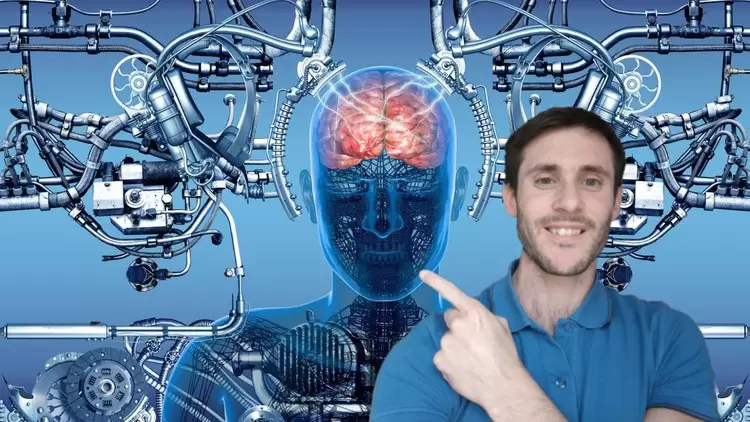
欢迎来到我的机器学习和数据分析课程,该课程将教您如何使用高级算法解决实际数据问题。我是 Emanuele,一名拥有高级算法博士学位的机械工程师,我将担任这门课程的讲师。
本课程包括四个主要部分:
- 第 1 部分:傅里叶分析和小波概述。您将学习这两个用于分析不同领域中的信号和图像的强大数学工具的基础知识。
- 第 2 部分:使用傅立叶级数、变换和小波进行数据分析。您将学习如何应用这些方法在时域和频域中高效且有效地处理和探索数据。
- 第 3 部分:机器学习方法。您将学习如何使用使计算机能够从数据中学习并做出智能预测或决策的技术,例如线性回归、曲线拟合、最小二乘法、梯度下降、奇异值分解(等等)。
- 第 4 部分:动力系统。您将学习如何使用数学方程对随时间变化的复杂非线性现象进行建模和理解。我们还将机器学习技术应用于动态系统,例如SINDy 算法。
在本课程结束时,您将能够:
- 了解傅里叶分析和小波的原理和应用
- 使用傅里叶级数和变换来分析各个领域的数据
- 将机器学习方法应用于不同的问题
- 使用小波从数据中提取特征
- 通过实际示例了解自然数据稀疏性的重要性,以及压缩感知的革命性概念。
- 从时间序列数据(SINDy 算法)中发现动力系统的控制方程。
————————————————————————————————————————————
让我们提供有关本课程主要部分的更多详细信息:
第 1 部分构成对傅里叶分析和小波分析的初步介绍。重点将放在理解与这些基本主题相关的最相关概念上。
在第 2 部分中,介绍了傅里叶级数和傅里叶变换。虽然显示了最重要的数学公式,但重点不在数学上。这部分的重点之一是展示傅里叶变换的一种可能应用:谱导数。然后,我们通过展示多分辨率分析的一些应用来更详细地介绍小波的概念。
这是用Matlab举例说明的,没有使用严格的数学公式。即使学生无法访问 Matlab,他们也可以跟随并获得直觉。
这部分的另一个重要成就是对著名的计算FFT方法进行了简单而透彻的解释。
还有一些关于Inverse Wavelet Transform和Uncertainty principle的extra(这里看到的数学比较多,不过这是extra,想跳过的直接跳过)。
在第三部分,介绍了一些机器学习技术:曲线拟合、梯度下降、线性回归、奇异值分解(SVD)、 分类、高斯混合模型(GMM)等方法。这部分的目标是展示一些实际应用并阐明它们的实用性。
我们还将关注稀疏性和压缩感知,它们是信号处理中的相关概念。稀疏性是指信号在某个域中可以用少数几个非零系数来表示,例如频率或小波。压缩传感意味着可以通过利用信号的稀疏性和使用优化技术,从比奈奎斯特-香农采样定理要求的更少的测量中重建信号。这些概念对于降低机器学习应用程序(例如图像处理或雷达成像)中数据的维数和复杂性非常有用。
第 4 部分是对动力学模型的独立介绍。这部分包含的模型有猎物-捕食者模型、流行病模型、人口增长的逻辑模型。
学生将学习如何使用名为Scilab (与 Matlab 非常相似)的免费开源软件来实现这些模型。
与第 4 部分相关的是一个名为SINDy 的机器学习技术的应用,它是Sparse Identification of Nonlinear Dynamics 的首字母缩写。它是一种机器学习算法,可以从时间序列数据中发现动力系统的控制方程。主要思想是假设系统可以用一组稀疏的非线性函数来描述,然后使用稀疏促进回归技术找到最适合数据的这些函数的系数。这样,SINDy 可以恢复复杂系统的可解释和简约模型。
注意:对于本课程的一些讲座,我受到了SL Brunton 和 JN Kutz 的《数据驱动科学与工程》一书的启发。这本书是一个很好的信息来源,可以深入挖掘课程中讨论的大多数(尽管不是全部)主题。
Published 4/2023
MP4 | Video: h264, 1280×720 | Audio: AAC, 44.1 KHz
Language: English | Size: 8.76 GB | Duration: 10h 5m
要求
- 熟悉一些线性代数将使课程更容易跟上。
- 微积分可能有助于更大程度地理解机器学习技术和小波。我的主要目的不是向您展示数学,而是具有一定的数学背景,您将能够更透彻地理解其中的内容
此课程面向哪些人:
- 寻求加强对机器学习技术的理解并加强他们的游戏的数据科学家
- 想成为数据分析师或 AI 爱好者
- 机器学习工程师
- 软件开发人员
- 应用数学家
- 物理学家
- 研究人员
- 程序员
- 任何想学习如何使用高级算法解决实际数据问题的人。它对那些对机器学习和数据分析感兴趣的人特别有用。
你将会学到的
- 了解傅里叶分析和小波的原理和应用(强调物理洞察力而不是数学)
- 使用傅里叶级数和变换来分析各个领域的数据
- 将机器学习方法应用于不同的问题
- 使用小波从数据中提取特征
- 了解自然数据稀疏性的重要性
- 通过实际示例了解压缩传感的革命性概念。
- 从时间序列数据中发现动力系统的控制方程(SINDy 算法)
- 使用 Matlab 实现高效的机器学习算法
- 理解并应用奇异值分解 (SVD)(我们甚至证明了这一点!)
- 了解如何使用 SVD 来近似图像
- 从实例中理解最小二乘法(LSM)
- 理解并应用快速傅立叶变换 (FFT) – 迄今为止发现的最重要的算法之一
- 理解和应用离散余弦变换 (DCT)
- 了解如何推导逆小波变换
- 了解如何推导反离散余弦变换
- 了解如何推导傅里叶逆变换
- 了解如何推导不确定性原理,以及这如何影响时频分辨率
Overview
Section 1: Overview of Fourier and Wavelet Analysis
Lecture 1 Overview of Fourier Analysis
Lecture 2 Space-Frequency resolution for the Short Time Fourier Transform
Lecture 3 Wavelets and Space-Frequency resolution
Section 2: Data Analysis with Fourier Series and Transform
Lecture 4 Summary of Fourier Series and Fourier Transform
Lecture 5 Notation for the Fourier Transform
Lecture 6 Fourier Transform of the derivative of a function
Lecture 7 The importance of the Fast Fourier Transform (FFT)
Lecture 8 Spectral derivative
Lecture 9 Wavelets and Multiresolution Analysis
Lecture 10 Extra: Why the Dirac delta helps derive the Inverse Fourier Transform
Lecture 11 Extra: Mathematical derivation of the Inverse Wavelet Transform
Lecture 12 Extra: Uncertainty principle – mathematical proof
Section 3: Methods in Machine Learning
Lecture 13 Curve fitting
Lecture 14 Example of curve fitting – least squares method
Lecture 15 Gradient descent
Lecture 16 Singular Value Decomposition – SVD
Lecture 17 Approximation of images with the SVD
Lecture 18 Supervised machine learning – extraction of features with SVD and Wavelets
Lecture 19 Linear regression: least squares method in matrix form
Lecture 20 Linear regression: sensitivity to outliers in the data
Lecture 21 Classification/decision trees
Lecture 22 Gaussian Mixture Models
Lecture 23 Example of Gaussian mixture model
Section 4: Sparsity and Compressed Sensing
Lecture 24 Sparsity and compressed sensing: intro to sparsity
Lecture 25 Sparsity and compressed sensing: why “natural” signals are compressible
Lecture 26 Sparsity and compressed sensing: intro to compressed sensing
Lecture 27 Example of compressed sensing
Lecture 28 Definition of the Discrete Cosine Transform (DCT) and its inverse
Lecture 29 Extra: formula which is crucial to finding the Inverse Discrete Cosine Transform
Section 5: Dynamical systems
Lecture 30 Introduction to the section on mathematical models
Lecture 31 Pure prey-predator model
Lecture 32 Equilibrium points and their stability
Lecture 33 Equilibrium points in the prey-predator model
Lecture 34 Introduction to Scilab
Lecture 35 Constructing the model with Scilab part 1
Lecture 36 Constructing the model with Scilab part 2
Lecture 37 How parameters affect the output of the model
Lecture 38 Influence of fishing on the model
Lecture 39 Addition of logistic terms to the model
Lecture 40 Model on the evolution of epidemics
Lecture 41 Mathematical analysis of stability
Lecture 42 Simulation and mathematics of the logistic model with one population
Section 6: Machine learning applied to dynamical systems
Lecture 43 Dynamical systems and chaos: Lorenz system
Lecture 44 Machine learning to find dynamical models behind data (SYNDy algorithm)
Section 7: Proof of the SVD decomposition
Lecture 45 Introduction to this section on the proof of the SVD
Lecture 46 Diagonalization theorem in Linear Algebra
Lecture 47 Intuition behind the Singular Value Decomposition (SVD)
